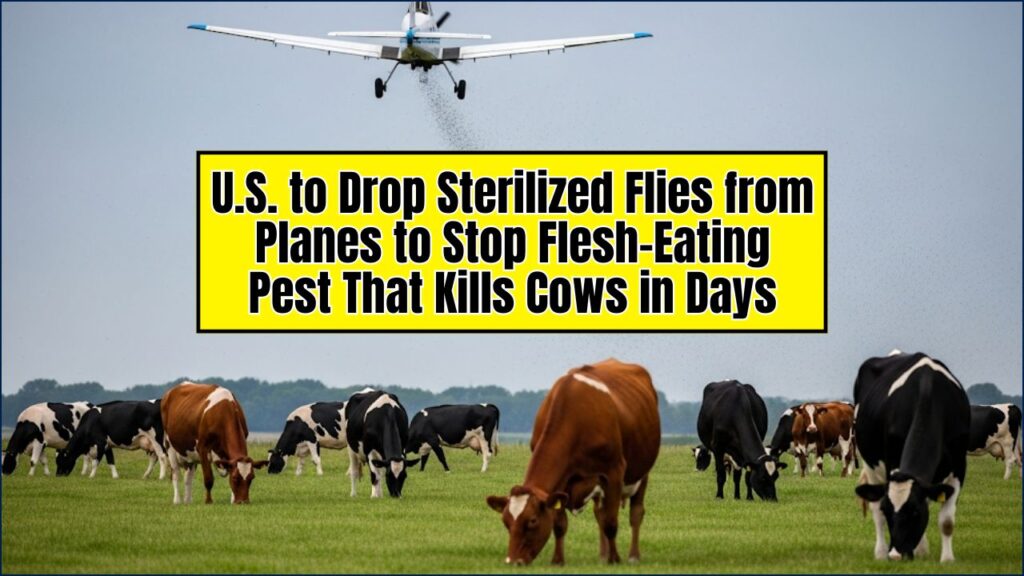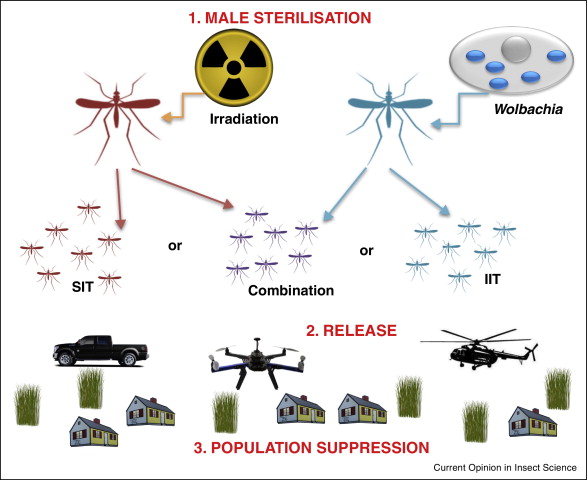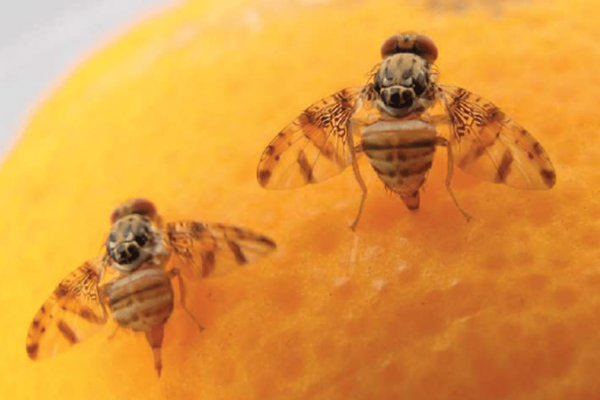
The U.S. government has recently announced a bold plan to fight one of the most dangerous agricultural pests—the New World screwworm—by releasing sterilized male flies from planes over areas at risk. This innovative approach uses a technique called Sterile Insect Technique (SIT) to control the screwworm population, which can devastate livestock in just a few days. In this article, we’ll explore the science behind this strategy, its potential impact on farmers, and why it matters to everyone from ranchers to taxpayers.
U.S. to Drop Sterilized Flies from Planes
| Key Data | Facts |
|---|---|
| Pest Name | New World Screwworm (Cochliomyia hominivorax) |
| Threat | Flesh-eating maggots that infest wounds of warm-blooded animals |
| Sterile Fly Production | 300 million sterile flies per week to be released |
| Investment | $8.5 million facility in Texas and a $21 million facility in Mexico |
| Program Launch Date | Ongoing since 2025 with continuous efforts |
| Impact | Potential to save billions in agricultural losses and protect livestock |
| Official Website | USDA – Agricultural Research Service |
The U.S. government’s innovative approach to combating the New World screwworm using sterilized flies represents a major step forward in pest management. By using the Sterile Insect Technique, the USDA is addressing one of the most pressing threats to livestock and agriculture. With ongoing efforts in fly production, expansion of facilities, and collaboration with Mexico, this initiative is set to protect billions of dollars in livestock and contribute to the overall health of the agricultural industry.
What is the New World Screwworm?
The New World screwworm (Cochliomyia hominivorax) is a parasitic fly that preys on warm-blooded animals, including cows, sheep, and even humans. Female flies lay their eggs in open wounds, where the larvae hatch and begin feeding on the flesh. This process can lead to severe infections and, in some cases, death if left untreated. In livestock, screwworm infestations can be disastrous, with entire herds at risk.

But this pest isn’t just an agricultural threat; it has a significant economic impact too. If left unchecked, an infestation can lead to multi-million-dollar losses, especially in livestock-heavy areas like Texas, which is one of the largest cattle-producing states in the U.S. Understanding how to control this pest is critical for preserving the livelihoods of farmers and the nation’s agricultural economy.
The Plan to Combat the Screwworm: Sterilized Flies Released from Planes
To combat this parasite, the U.S. government is using an innovative and environmentally friendly solution called the Sterile Insect Technique (SIT). This method has been successful in controlling other pest populations and is now being applied to the New World screwworm.
What Is the Sterile Insect Technique?
The Sterile Insect Technique (SIT) is a biological control method that involves breeding large numbers of sterile male flies, irradiating them to prevent reproduction, and releasing them into the wild. These sterile males mate with females, but since they are infertile, no viable eggs are produced. As a result, the screwworm population slowly diminishes.

How Does It Work?
The process begins at fly production facilities where millions of sterile male flies are bred and irradiated every week. Once sterilized, they are released from planes over the affected areas. The sterile males mate with wild females, and because no viable eggs are produced, the population begins to shrink.
The USDA aims to produce up to 300 million sterile flies per week and release them over regions at risk, including southern Texas and northern Mexico. This method not only provides a sustainable way to reduce pest numbers but also ensures minimal environmental impact.
A Look Back: History of Screwworm Eradication
The use of sterile flies isn’t new. The SIT method was successfully employed in the 1950s to eradicate screwworm populations in the southeastern U.S. Over time, similar techniques have been used to tackle other pests, such as the tsetse fly in Africa and the Mediterranean fruit fly in California. The lessons learned from past programs have made this current effort even more effective.
In fact, the screwworm eradication program has been one of the most successful pest management projects in U.S. history. It shows how biological control methods can offer an alternative to toxic chemicals, which can harm the environment and human health.
Technological Innovations in Fly Production
Behind the success of the program is cutting-edge technology. The breeding of sterile flies is a highly specialized process that requires precision. Advances in radiation techniques allow for the sterilization of flies without altering their behavior or lifespan. New automated systems have also made the process more efficient, helping produce larger quantities of sterile flies at a faster rate.
In addition, researchers are exploring genetic modifications to create flies that are even more effective at mating with wild females, thereby improving the efficiency of the program. The technology behind sterile fly production is not only critical for the success of this initiative but also demonstrates the power of innovation in solving complex agricultural challenges.
The Global Impact of SIT
While this program targets the New World screwworm, the Sterile Insect Technique has been successfully used around the world. From combating the Mediterranean fruit fly in California to fighting the tsetse fly in Africa, SIT has proven to be an effective tool in pest management. These successes showcase the versatility of SIT and underscore its importance in global agriculture.

For example, in Tanzania, the release of sterile tsetse flies has helped reduce the spread of sleeping sickness—a disease transmitted by the tsetse fly. Similarly, in the Caribbean, SIT has been instrumental in preventing the spread of invasive pests that could damage crops.
Economic Impact Beyond Agriculture
The economic impact of screwworm infestations isn’t limited to the immediate losses in livestock. If the pest were to spread unchecked, it could affect tourism, wildlife conservation, and even public health. A single outbreak could lead to travel restrictions, which would hurt local economies, particularly in rural areas that rely on agriculture and tourism.
By preventing the spread of this pest, the USDA is not only protecting livestock but also supporting the broader economy. A thriving agricultural industry ensures a stable food supply and a strong workforce for the nation.
The Future of the Program: Expansion and Long-Term Goals
The U.S. is committed to continuing the fight against the screwworm. New production facilities are being built in Mexico to complement the efforts in Texas. The goal is to keep screwworm populations under control and eventually eradicate them altogether. However, this is a long-term commitment, and success depends on cooperation between the U.S., Mexico, and other affected countries.
In the future, the SIT program may be expanded to other agricultural pests, further improving crop yields and livestock health worldwide. Innovations in genetics and artificial intelligence could take these programs to the next level, making pest management more precise and less reliant on chemicals.
Ethical Considerations and Public Opinion
While the sterile fly release is an effective pest control strategy, it has raised some ethical questions. Is it right to release genetically modified organisms (GMOs) into the wild? What are the long-term consequences of introducing sterilized flies into ecosystems? These are important questions that need to be addressed.
Public opinion on genetically modified organisms is divided, but the USDA has worked hard to ensure transparency and involve the public in the conversation. The program’s benefits far outweigh the risks, but it’s important to continue to monitor the effects on the environment and local wildlife.
FAQs
What is the Sterile Insect Technique (SIT)?
The Sterile Insect Technique (SIT) involves breeding sterile male flies, irradiating them to prevent reproduction, and releasing them into the wild. These sterile males mate with females, leading to a reduction in the pest population.
How does the sterile fly release work?
Sterile male flies are bred and released over affected areas. These flies mate with wild females, but no offspring are produced, leading to a gradual decrease in the screwworm population.
Is this method safe for the environment?
Yes! The release of sterile flies is non-toxic and environmentally friendly. It does not harm wildlife or ecosystems, making it a safe alternative to chemical pesticides.
How many sterile flies are released?
The USDA produces and releases up to 300 million sterile flies per week in high-risk areas such as Texas and Mexico.
What is the long-term goal of this project?
The long-term goal is to completely eradicate the screwworm from the U.S. and Mexico, preventing future outbreaks and protecting the agricultural industry.








